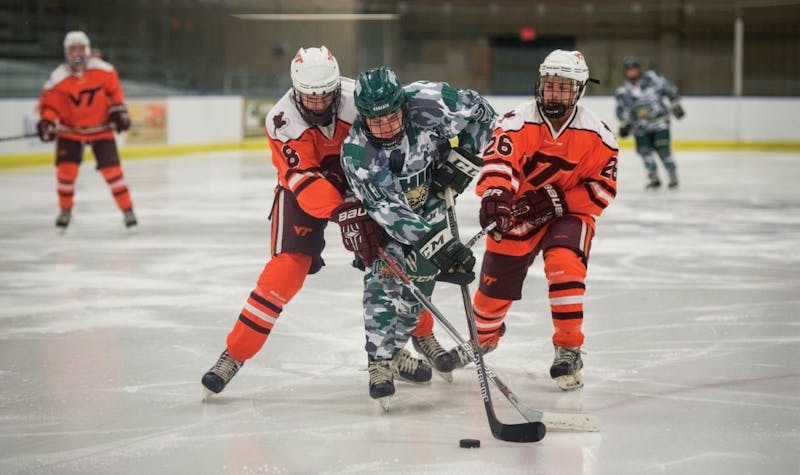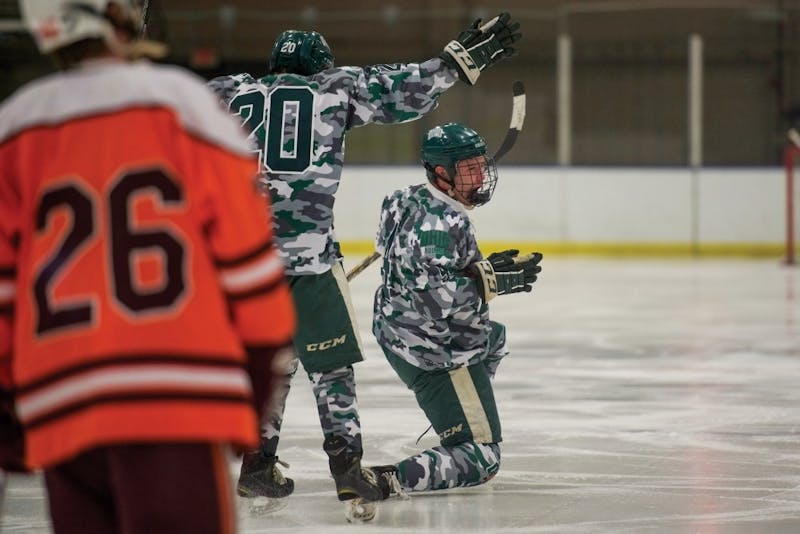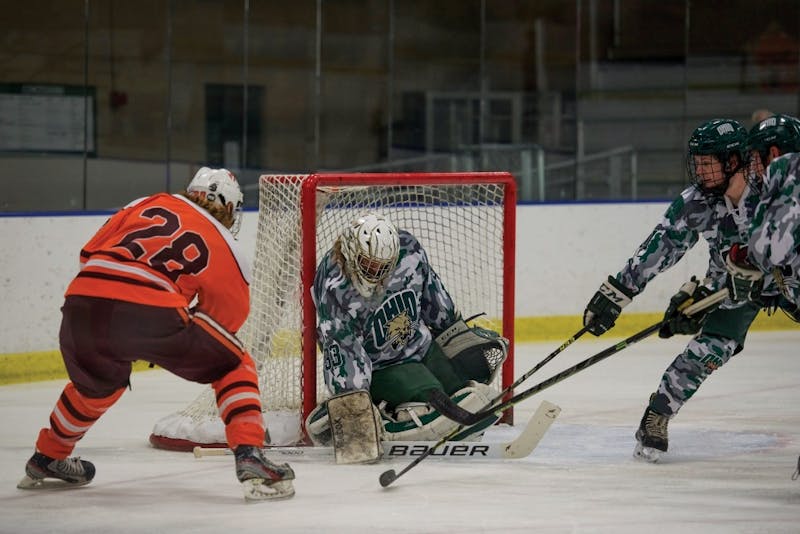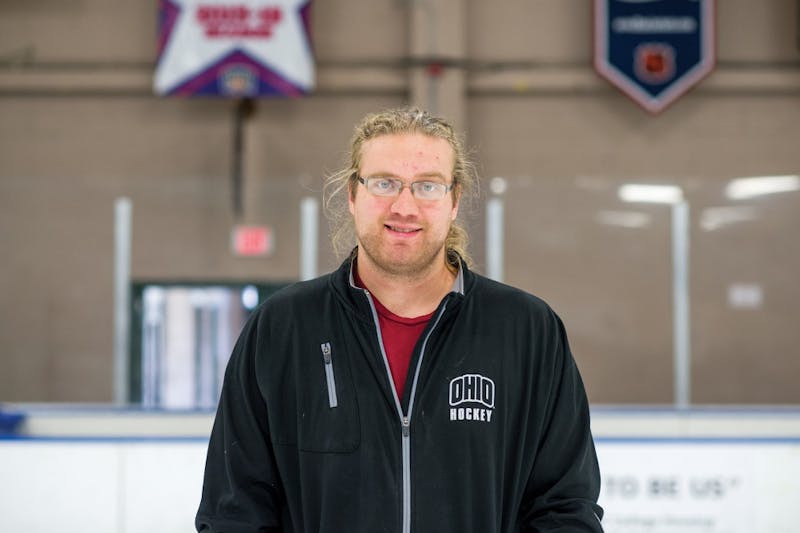


Blake Nissen
11.17.16
The puck drops to the ice, and the crack it makes echoes eerily throughout Bird Arena. The sound bounces from wall to wall, largely unimpeded by the 50 or so people that are seated or standing sporadically in the bleachers, making little noise to drown out the clacking of sticks and thud of colliding bodies.
It is a far cry from the scene Bird Arena is used to seeing on Fridays, when raucous cheers fill the building like water fills a cup. Crowds that can grow as large as 1,800 strong pack the close confines of the arena, complete with a student group known as Gang Green running around the rink after each goal.
But on that particular Friday, there is no Gang Green to be seen, and no foundation-shaking cheers for any of the goals Ohio scores. A modest applause briefly rings out as the clock runs out in the final period, the scoreboard showing a score of Ohio 8, Virginia Tech 1.

Blake Nissen
Ohio's Jordan Frasse celebrates during a game against Virginia Tech at Bird Arena on Nov. 11.
Without any further pageantry, players and the remaining supporters quietly file out of the arena. Some in attendance have no idea the Ohio team they just watched is now 10-2-3, a top five team in its region. Others are simply waiting to meet back up with the friends they just watched on the ice for two hours. Players are just happy for the chance to finish a Friday game before midnight.
It is not the hockey team many in Athens know. It is that team’s younger brother, a seven-year-old program that plays at the American Collegiate Hockey Association Division II level.
And it might be the best team nobody knows about.
Entering the 2010-11 season, Ohio was seven years removed from a ten-year stretch that saw it make the ACHA national championship game six times, resulting in four titles, including three in a row from 1995-97. Even though the team hadn’t reached that final game of the season since, interest in the program was growing every year, with more than 80 potential players showing up to tryouts hoping to make a roster that typically holds about 28 players, most of whom are recruited and guaranteed a spot before tryouts even begin.
With such a surplus of talent interested in joining Ohio hockey, former Division I players Sean Roach and Nick Frasse approached then-D1 head coach Dan Morris with the goal of establishing a second team and placing it in the ACHA’s second division.
“The whole purpose, I think, was to get more kids to continue playing hockey at the collegiate level,” Division II head coach Phil Oberlin said. “To have that many kids looking to play competitive hockey, why not have two teams on a campus where hockey has had a rich tradition of winning?”
The team played its first season in 2010-11, under the direction of graduate assistant Matt Staehely. Oberlin, an Athens native and former Bobcat hockey player, took over as head coach in the program’s second year, and has remained in that position ever since.
The road to such success hasn’t been an easy one, though. Unlike the D1 team, the D2 staff doesn’t have the resources to go out and watch players at various showcases to do in-person recruiting. Instead, Oberlin relies on junior league stats and reaches out to coaches.
The majority of Ohio D2 hockey, however, is on the team because current and former players spread good word about Bobcat hockey.
“What really attracted me to Ohio University was my brother playing hockey here,” sophomore forward Matty Geither, a Lakewood native and brother of a former-D1 forward, said. “I knew realistically, (D1) was a tough team to make, so I didn’t have the highest expectations. But I’m glad it all worked out. D2 is awesome and I’m having a lot of fun doing it.”
Narrowly missing that cut to play at the D1 level instead of D2 bears serious financial weight for players. Because of D1’s consistent ticket sales and alumni backing, players on the team have all expenses covered for them. D2 players, meanwhile, are responsible for covering all of their own transportation, hotels, equipment and other costs that come with playing for the team.

Blake Nissen
Ohio's Connor Hoarty dribbles down the ice during a game against Virginia Tech at Bird Arena on Nov. 11.

Blake Nissen
Pat Daniels looks for a pass during the game against Virginia Tech.

Blake Nissen
Jacob Bloomfield defends the goal during the game against Virginia Tech.



First-time players pay $2,500 in fees, while returning players pay $2,100, with the extra $400 from newcomers used to cover helmets, jerseys, gloves and other apparel. That financial burden isn’t enough to dissuade prospective players, though.
“I’ve never encountered anyone who wanted to play but then said they couldn’t because they didn’t want to spend that much money,” Jake Bloomfield, a Portsmouth native and senior goalie on the D2 team, said. “All the guys on the team, we find a way to swing it.”
The most direct remedy to knocking down those player fees, or even ditching them entirely, would be to bring in the kind of ticket sales that the D1 team does. Tickets for D2 games are $4 or $1 with a student ID. For the time being, however, the discrepancy in the crowds the two teams draw is, in the words of Oberlin, “night and day.”
“There’s really no adequate way to describe playing at Bird Arena during a Division I game,” Bloomfield, who played all of last season at the D1 level, said. “It’s like playing in a whole different arena, honestly. The energy, the excitement is incredible. And it’s a shame the D2 team doesn’t get that because the team is still exciting and they’re still extremely competitive.”
There are many factors that play into the D2 team garnering less attention than the D1 team, beginning with the fact that the program is so young, few students even know that it exists.
“I think once people would become aware of it, they’d come support them too,” Bradley Hlibok, a junior studying finance who regularly attends games of both teams, said. “Right now, I think it’s more just something where if you know someone on the team, you come watch.”
Complicating matters further is the peculiar schedule the D2 team must adhere to throughout the season. Because they must share an arena with the D1 team, and occasionally share a home date, the team is forced to play Friday games after the conclusion of the D1 game, which could be after 10 p.m., before turning around and playing again Saturday afternoon.
“It is difficult, honestly,” Bloomfield said. “But I think we have pretty experienced guys on our team. You get used to it after a while. You figure out how to structure your day so that you’re ready for it.”
One of the first questions D2 prospects ask their coaches when they first enter the program is whether or not there are opportunities to move up to D1 with the right amount of proven ability on the ice. The answer they hear is a complicated one.
“That option is always open,” Oberlin said. “It’s not gonna happen often, though. If you look at it from (D1’s) standpoint, they’d rather have a kid come in and be able to play for four years than have someone who is able to only play two years.”

Carl Fonticella
Senior goalie Jake Bloomfield poses for a portrait inside of Bird Arena. During his freshman and sophomore years Bloomfield played for the D2 team but played on the D1 team his junior year. Bloomfield is the only person to have played on both the D2 and the D1 team.
The history matches that sentiment. Last year, D1 head coach Sean Hogan offered Bloomfield a spot on the D1 team — the only promotion any D2 player has achieved since the start of the program.
He spent the entire 2015-16 season with the team, playing in three games and blocking 48 of the 51 shots he faced.
Bloomfield is back at the D2 level for his senior season, opting for more playing time, but his success at providing depth in the goalie position is proof that the newer team is not a drastic step down in talent from the D1 squad. In fact, Hogan said there are “a handful” of guys on the D2 team this year with the talent to be on the D1 roster.
The narrower the gap between the two teams, the better for Ohio hockey as a whole. That’s why the D2 club won’t be utilized as a minor league feeder system of any kind to the D1 team.
“It’s not set up to be a minor league team,” Hogan said. “They’re there for the same reason we are, and that’s to win a championship.”
That championship is in closer proximity this year than ever before for the D2 team, who sits at No. 5 in the most recent Southeast Region rankings. And if the team brings a title to Bird Arena, bigger crowds may follow close behind.
“We’re doing pretty well right now,” Geither said. “I think people are starting to get the idea that we’re a fun team to watch.”